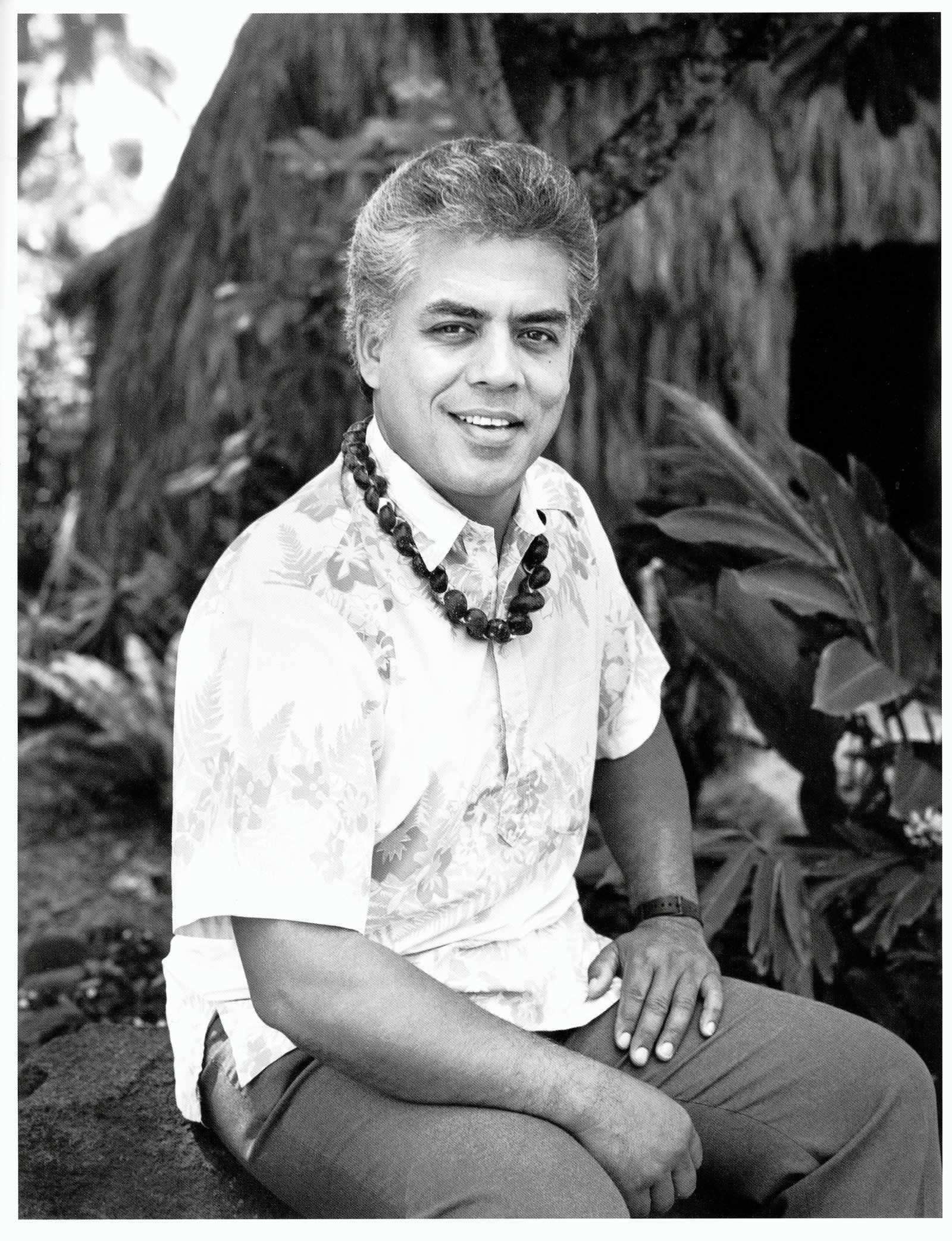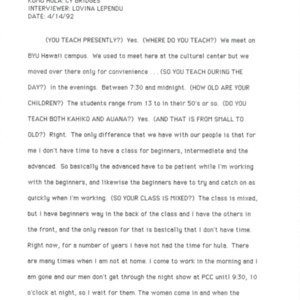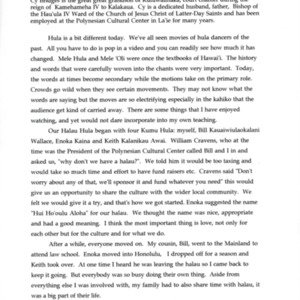Cy M. Bridges
Title
Cy M. Bridges
Subject
Nā Kumu Hula Cy M. Bridges - Nānā I Nā Loea Hula Volume 2 Page 23
Description
Cy M. Bridges, the great grandson of Kuluwaimaka who was a court chanter during the reign of Kamehameha II to Kalākaua, is a Bishop of the Hauʻula IV Ward of the Church of Jesus Christ of Latter-Day Saints and has been employed at the Polynesian Cultural Center in Lāʻie for many years.
Hula is a bit different today. We’ve all seen movies of hula dancers of the past. All you have to do is pop in a video and you can readily see how much it has changed. Mele hula and mele oli were once the textbooks of Hawaiʻi. The History and words that were carefully woven into the chants were very important. Today the words at times become secondary while the motions take on the primary role. Crowds go wild when they see certain movements. They may not know what the words are saying but the moves are so electrifying especially in the kahiko that the audience get carried away. There are some things that I have enjoyed watching and yet would not dare incorporate into my own teaching.
Our hālau hula began with four kumu hula: myself, Bill Kauaiwiulaokalani Wallace, Enoka Kaina, and Keitli Kalanikau Awai. William Cravens, who at the time was the President of the Polynesian Cultural Center, called Bill and me in and asked us, “Why don’t we have a hālau?” We told him it would be taxing and would take so much time and effort to have fund-raisers. Cravens said, “Don’t worry about any of that. We'll sponsor it and fund whatever you need.” We felt we would give it a try and that’s how we got started. Enoka suggested the name Hui Hoʻoulu Aloha for our hālau. We thought the name was nice, appropriate, and had a good meaning. I think the most important thing is love, not only for each other but for the culture and for what we do.
After a while everyone moved on. I dropped off for a season but I came back to keep the hālau going. Aside from everything else I was involved with, my family had to also share time with the hālau. It was a big part of their life.
Ever since l was quite young, I was fascinated not so much with the dance but more so with the chanting and how the voice was used as well as the haunting sounds of the ipu and palm. I wanted to learn how they did that. The very first training I got was really from my mom and grandmother. Now this was interesting because they were not chanters or hula people at all however they would tell me how it should or shouldn’t sound based on what they had observed through family members growing up. And as for myself, I would listen and mimic recordings of chanters that I heard especially our tūtū.
My formal hula training began when I was in high school with Aunty Sally Wood (Naluai) at the Polynesian Cultural Center in Lāʻie. I consider her my hula mother because she was my first formal teacher and I was with her for a number of years and graduated under her tutelage.
Aunty graduated me fourteen years after l first started dancing with her. She called me early one morning. She was crying on the phone and told me she was sorry. I didn’t quite know what she was talking about. She said to me, “I see a lot of kumu hula who are teaching and entering competitions. I thought of my own students who I’ve trained and they didn’t ʻūniki. I want you to graduate.” So our group got together and seriously started training once again. Her nieces Sunday and Ellen Gay were the first to graduate. Keith and I followed soon after.
While still with Aunty Sally I also began training with Aunty Hoakalei Kamau‘u. it first started when Aunty Hoakalei came down to Church College of Hawaii to help us with a Hawaiian Club assembly. Afterwards Aunty needed male teachers to help her with performances and hula workshops. In 1976 a performing group went to the South Pacific Festival of Arts in Rotorua, New Zealand and Aunty Hoakalei was our coordinator. It was a small group and I was very fortunate to be a part of it.
During the time we were with Aunty Hoakalei. I also learned from other hula masters through our involvement with the workshops, hōʻike, and the Arts Festivals, etc. We were able to learn the stylings of Aunty Edith Kanaka‘ole and her daughters Pua and Nalani who were also in the New Zealand group. I was fascinated when Aunty Edith would explain about the different winds and rains or other elements and how they were associated with the various chants we learned. I also had the opportunity to learn from Aunty Pat Nāmaka Bacon most of which were in conjunction with other festivals. I still call on her today when I need help. Like many others, she is a special person and a great inspiration to me.
Aunty Sally is a graduate of Lokalia Montgomery and I had the opportunity of also learning from Aunty Lokalia. I first met her when we did a performance for the crowning of the Lei Day Queen at Kapi'olani Park Bandstand. About a month later she invited me to come and learn from her. What was even more special was the fact that one of Aunty Lokalia’s teachers was my tūtūman while he was at Mossman’s Lalani Hawaiian Village in Waikīkī.
I did not train intensively in chanting with Aunty Sally. Basically I was given the words, she would chant it for me, and I would follow her until I got the gist of it. But as I went to other teachers, I found that Aunty Pele and Lokalia would incorporate techniques that were slightly different. I gathered a little bit from all of my teachers. Noelani Kamekona took me to Kaʻupena Wong. At that time he had just finished working with another student and was not able to dedicate the same time and effort with me however he gave me some chants and shared some techniques and said I could call on him at any time. That in itself was a great boost for me.
My style is a combination of all of my kumu. It is so very important to me what my mom, grandmother, Aunty Sally, Aunty Hoakalei, Aunty Pat, and others think about what I do and how I do it. I only wish I can bring honor to them and what they’ve shared with me. I hope I never disappoint them.
The interesting thing with our hālau is that our haumāna are from Oʻahu, the Cook Islands, New Zealand, Fiji, Rotuma, Honolulu, Kauaʻi, Big Island, Japan, and Spain. They’re from all over the world and they come to learn and love the hula. One of the greatest joys I get is seeing someone who has never danced, be able to do it well. They can understand, appreciate, and love Hawaii, its people, and its culture through its unique music and dance. Oh the pain! Aahhh I guess it’s worth it!
Nānā I Nā Loea Hula 23
Hula is a bit different today. We’ve all seen movies of hula dancers of the past. All you have to do is pop in a video and you can readily see how much it has changed. Mele hula and mele oli were once the textbooks of Hawaiʻi. The History and words that were carefully woven into the chants were very important. Today the words at times become secondary while the motions take on the primary role. Crowds go wild when they see certain movements. They may not know what the words are saying but the moves are so electrifying especially in the kahiko that the audience get carried away. There are some things that I have enjoyed watching and yet would not dare incorporate into my own teaching.
Our hālau hula began with four kumu hula: myself, Bill Kauaiwiulaokalani Wallace, Enoka Kaina, and Keitli Kalanikau Awai. William Cravens, who at the time was the President of the Polynesian Cultural Center, called Bill and me in and asked us, “Why don’t we have a hālau?” We told him it would be taxing and would take so much time and effort to have fund-raisers. Cravens said, “Don’t worry about any of that. We'll sponsor it and fund whatever you need.” We felt we would give it a try and that’s how we got started. Enoka suggested the name Hui Hoʻoulu Aloha for our hālau. We thought the name was nice, appropriate, and had a good meaning. I think the most important thing is love, not only for each other but for the culture and for what we do.
After a while everyone moved on. I dropped off for a season but I came back to keep the hālau going. Aside from everything else I was involved with, my family had to also share time with the hālau. It was a big part of their life.
Ever since l was quite young, I was fascinated not so much with the dance but more so with the chanting and how the voice was used as well as the haunting sounds of the ipu and palm. I wanted to learn how they did that. The very first training I got was really from my mom and grandmother. Now this was interesting because they were not chanters or hula people at all however they would tell me how it should or shouldn’t sound based on what they had observed through family members growing up. And as for myself, I would listen and mimic recordings of chanters that I heard especially our tūtū.
My formal hula training began when I was in high school with Aunty Sally Wood (Naluai) at the Polynesian Cultural Center in Lāʻie. I consider her my hula mother because she was my first formal teacher and I was with her for a number of years and graduated under her tutelage.
Aunty graduated me fourteen years after l first started dancing with her. She called me early one morning. She was crying on the phone and told me she was sorry. I didn’t quite know what she was talking about. She said to me, “I see a lot of kumu hula who are teaching and entering competitions. I thought of my own students who I’ve trained and they didn’t ʻūniki. I want you to graduate.” So our group got together and seriously started training once again. Her nieces Sunday and Ellen Gay were the first to graduate. Keith and I followed soon after.
While still with Aunty Sally I also began training with Aunty Hoakalei Kamau‘u. it first started when Aunty Hoakalei came down to Church College of Hawaii to help us with a Hawaiian Club assembly. Afterwards Aunty needed male teachers to help her with performances and hula workshops. In 1976 a performing group went to the South Pacific Festival of Arts in Rotorua, New Zealand and Aunty Hoakalei was our coordinator. It was a small group and I was very fortunate to be a part of it.
During the time we were with Aunty Hoakalei. I also learned from other hula masters through our involvement with the workshops, hōʻike, and the Arts Festivals, etc. We were able to learn the stylings of Aunty Edith Kanaka‘ole and her daughters Pua and Nalani who were also in the New Zealand group. I was fascinated when Aunty Edith would explain about the different winds and rains or other elements and how they were associated with the various chants we learned. I also had the opportunity to learn from Aunty Pat Nāmaka Bacon most of which were in conjunction with other festivals. I still call on her today when I need help. Like many others, she is a special person and a great inspiration to me.
Aunty Sally is a graduate of Lokalia Montgomery and I had the opportunity of also learning from Aunty Lokalia. I first met her when we did a performance for the crowning of the Lei Day Queen at Kapi'olani Park Bandstand. About a month later she invited me to come and learn from her. What was even more special was the fact that one of Aunty Lokalia’s teachers was my tūtūman while he was at Mossman’s Lalani Hawaiian Village in Waikīkī.
I did not train intensively in chanting with Aunty Sally. Basically I was given the words, she would chant it for me, and I would follow her until I got the gist of it. But as I went to other teachers, I found that Aunty Pele and Lokalia would incorporate techniques that were slightly different. I gathered a little bit from all of my teachers. Noelani Kamekona took me to Kaʻupena Wong. At that time he had just finished working with another student and was not able to dedicate the same time and effort with me however he gave me some chants and shared some techniques and said I could call on him at any time. That in itself was a great boost for me.
My style is a combination of all of my kumu. It is so very important to me what my mom, grandmother, Aunty Sally, Aunty Hoakalei, Aunty Pat, and others think about what I do and how I do it. I only wish I can bring honor to them and what they’ve shared with me. I hope I never disappoint them.
The interesting thing with our hālau is that our haumāna are from Oʻahu, the Cook Islands, New Zealand, Fiji, Rotuma, Honolulu, Kauaʻi, Big Island, Japan, and Spain. They’re from all over the world and they come to learn and love the hula. One of the greatest joys I get is seeing someone who has never danced, be able to do it well. They can understand, appreciate, and love Hawaii, its people, and its culture through its unique music and dance. Oh the pain! Aahhh I guess it’s worth it!
Nānā I Nā Loea Hula 23
Citation
“Cy M. Bridges,” Nā Kumu Hula Archive, accessed September 16, 2025, https://nakumuhula.org/archive/items/show/109.






